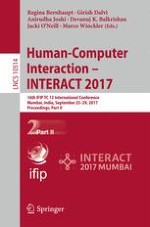2017 | OriginalPaper | Chapter
Subjective Usability, Mental Workload Assessments and Their Impact on Objective Human Performance
Author : Luca Longo
Published in: Human-Computer Interaction - INTERACT 2017
Publisher: Springer International Publishing
Activate our intelligent search to find suitable subject content or patents.
Select sections of text to find matching patents with Artificial Intelligence. powered by
Select sections of text to find additional relevant content using AI-assisted search. powered by
